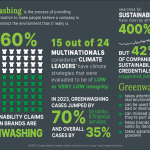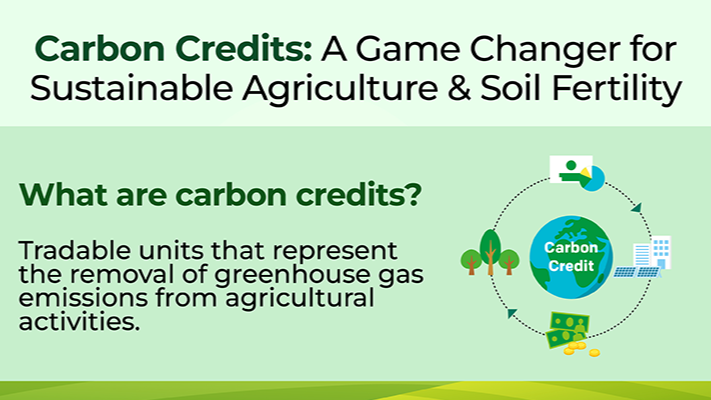Regenerative agriculture credits have emerged as a promising tool to incentivize sustainable farming practices and combat climate change. By rewarding farmers for adopting methods that improve soil health, sequester carbon, and enhance biodiversity, these credits aim to align agricultural production with environmental goals. However, despite their potential, regenerative agriculture credits face significant challenges. Issues such as inconsistent measurement standards, lack of transparency, and difficulties in verifying outcomes have raised concerns about their effectiveness and credibility. Additionally, the complexity of implementing these systems and ensuring equitable access for small-scale farmers further complicates their adoption. This article explores the main problems associated with regenerative agriculture credits and their implications for the future of sustainable farming.

- What Are the Main Problems With Regenerative Agriculture Credits?
- What are the negatives of regenerative agriculture?
- Why are people against regenerative agriculture?
- What are the critiques of carbon credits?
- What are some challenges to sourcing regenerative food?
- Frequently Asked Questions (FAQ)
- What are the challenges in measuring the effectiveness of regenerative agriculture credits?
- How do regenerative agriculture credits address the issue of additionality?
- What are the risks of greenwashing in regenerative agriculture credit programs?
- How do regenerative agriculture credits impact small-scale farmers?
What Are the Main Problems With Regenerative Agriculture Credits?
Regenerative agriculture credits aim to incentivize sustainable farming practices that restore soil health, sequester carbon, and improve biodiversity. However, despite their potential, they face several challenges that hinder their effectiveness and widespread adoption. Below, we explore the main problems associated with regenerative agriculture credits.
1. Lack of Standardization in Measurement and Verification
One of the primary issues with regenerative agriculture credits is the lack of standardized methods for measuring and verifying the outcomes of regenerative practices. Different organizations use varying metrics to assess carbon sequestration, soil health, and biodiversity, leading to inconsistencies. This makes it difficult for farmers to understand what practices qualify for credits and for buyers to trust the legitimacy of the credits.
See Also Is Collecting Carbon From an Already Protected Land GREENWASHING?
Is Collecting Carbon From an Already Protected Land GREENWASHING?| Challenge | Impact |
|---|---|
| Inconsistent metrics | Confusion among farmers and buyers |
| High verification costs | Barrier for small-scale farmers |
2. High Costs for Farmers
Implementing regenerative practices often requires significant upfront investment in equipment, training, and labor. While credits are designed to offset these costs, the financial burden can still be prohibitive, especially for small-scale farmers. Additionally, the process of applying for and receiving credits can be complex and time-consuming, further discouraging participation.
| Challenge | Impact |
|---|---|
| Upfront costs | Limited adoption by small farmers |
| Complex application process | Reduced participation rates |
3. Limited Market Demand
The demand for regenerative agriculture credits is still relatively low compared to other types of carbon credits. Many companies and consumers are unaware of the benefits of these credits or are hesitant to pay a premium for them. This limited market demand reduces the financial incentive for farmers to adopt regenerative practices.
| Challenge | Impact |
|---|---|
| Low awareness | Reduced buyer interest |
| Price sensitivity | Lower credit prices |
4. Risk of Greenwashing
There is a growing concern that some companies may use regenerative agriculture credits as a form of greenwashing, where they claim environmental benefits without making meaningful changes to their practices. This undermines the credibility of the credits and discourages genuine efforts to promote sustainable agriculture.
See Also Carbon Emissions Trading Analysis
Carbon Emissions Trading Analysis| Challenge | Impact |
|---|---|
| Misleading claims | Erosion of trust |
| Lack of transparency | Reduced market confidence |
5. Long-Term Commitment Required
Regenerative agriculture is a long-term process that requires consistent effort and patience to see measurable results. However, many credit programs focus on short-term outcomes, which can misalign incentives for farmers. This disconnect can lead to frustration and a lack of sustained commitment to regenerative practices.
| Challenge | Impact |
|---|---|
| Short-term focus | Misaligned incentives |
| Delayed results | Reduced farmer motivation |
What are the negatives of regenerative agriculture?

High Initial Costs and Financial Barriers
One of the primary negatives of regenerative agriculture is the high initial costs associated with transitioning from conventional farming methods. Farmers often face significant financial barriers, including:
See Also Carbon Credit NFTs: An Increasingly Popular Real-World Use Case That You Should Know About!
Carbon Credit NFTs: An Increasingly Popular Real-World Use Case That You Should Know About!- Investment in new equipment: Switching to regenerative practices may require purchasing specialized machinery or tools.
- Training and education: Farmers need to learn new techniques, which can involve additional costs for workshops or consultants.
- Reduced yields during transition: As the soil rebuilds its health, there may be a temporary decline in crop productivity, impacting income.
Time-Intensive Transition Period
The transition to regenerative agriculture is not immediate and can take several years. This time-intensive process presents challenges such as:
- Soil regeneration: Restoring soil health and biodiversity requires patience and consistent effort.
- Adaptation period: Farmers must adjust to new practices, which can be labor-intensive and demanding.
- Uncertain outcomes: The long-term benefits may not be immediately visible, leading to frustration or skepticism.
Lack of Standardized Guidelines
Another drawback is the lack of standardized guidelines for implementing regenerative agriculture. This can lead to:
- Inconsistent practices: Without clear protocols, farmers may adopt varying methods, reducing overall effectiveness.
- Difficulty in measuring success: The absence of universal metrics makes it hard to assess progress or compare results.
- Confusion among practitioners: Farmers may struggle to determine which practices are most suitable for their specific conditions.
Market and Consumer Challenges
Regenerative agriculture faces hurdles in the marketplace, including:
- Limited consumer awareness: Many consumers are unfamiliar with the concept, making it harder to market regenerative products.
- Premium pricing: Products from regenerative farms often come at a higher cost, which may deter price-sensitive buyers.
- Supply chain complexities: Integrating regenerative products into existing supply chains can be logistically challenging.
Dependence on External Factors
The success of regenerative agriculture often depends on external factors beyond a farmer's control, such as:
- Climate variability: Extreme weather events can disrupt regenerative practices and delay progress.
- Policy and regulatory support: Lack of government incentives or supportive policies can hinder adoption.
- Access to resources: Farmers in resource-limited areas may struggle to implement regenerative practices effectively.
Why are people against regenerative agriculture?

Misunderstanding of Regenerative Agriculture Practices
One reason people oppose regenerative agriculture is due to a lack of understanding of its principles and practices. Many individuals are accustomed to conventional farming methods and may view regenerative practices as unconventional or untested. This skepticism can lead to resistance. Key points include:
- Perceived complexity: Regenerative agriculture involves practices like crop rotation, cover cropping, and no-till farming, which can seem complicated to those unfamiliar with them.
- Fear of change: Farmers may be hesitant to adopt new methods due to the risk of reduced yields or financial instability during the transition period.
- Misinformation: Some critics spread false claims about regenerative agriculture, such as it being less productive or more labor-intensive.
Economic Concerns and Initial Costs
Another major concern is the economic impact of transitioning to regenerative agriculture. Critics argue that the initial costs and potential financial risks outweigh the long-term benefits. Key points include:
- High upfront investment: Transitioning to regenerative practices often requires purchasing new equipment, seeds, and other resources.
- Uncertain profitability: Farmers may worry about the time it takes to see financial returns, especially if yields initially decrease.
- Market challenges: There may be limited demand or premium pricing for regeneratively grown products, making it harder to justify the switch.
Perceived Threat to Conventional Farming
Some individuals view regenerative agriculture as a threat to traditional farming systems. This perception can create resistance among those who rely on conventional methods for their livelihoods. Key points include:
- Disruption of established practices: Conventional farmers may feel that regenerative agriculture undermines their existing knowledge and expertise.
- Competition for resources: There may be concerns about land, water, and other resources being diverted to regenerative practices.
- Cultural resistance: Farming communities often have deep-rooted traditions, and any shift away from these can be met with opposition.
Lack of Scientific Consensus
Critics argue that there is insufficient scientific evidence to fully support the benefits of regenerative agriculture. This lack of consensus can fuel skepticism. Key points include:
- Limited long-term studies: While regenerative agriculture shows promise, some believe more research is needed to validate its effectiveness.
- Variable results: Outcomes can differ based on soil type, climate, and other factors, leading to doubts about its universal applicability.
- Overhyped claims: Some critics argue that the benefits of regenerative agriculture are exaggerated, creating unrealistic expectations.
Resistance from Agribusiness and Chemical Companies
Agribusiness and chemical companies often oppose regenerative agriculture because it threatens their profit margins. These industries rely heavily on the sale of synthetic fertilizers, pesticides, and other inputs that regenerative practices aim to reduce or eliminate. Key points include:
- Loss of revenue: Regenerative agriculture promotes natural solutions, which can reduce the demand for chemical products.
- Influence on policy: These companies often lobby against policies that support regenerative practices to protect their interests.
- Marketing campaigns: Some companies spread misinformation to discredit regenerative agriculture and maintain their market dominance.
What are the critiques of carbon credits?

1. Lack of Transparency and Accountability
One of the primary critiques of carbon credits is the lack of transparency and accountability in their implementation. Many projects that generate carbon credits are not adequately monitored, leading to questions about their actual environmental impact. Additionally, the verification processes are often criticized for being inconsistent or insufficiently rigorous.
- Verification issues: Independent audits may not always be thorough, leading to doubts about the legitimacy of carbon offset projects.
- Double-counting: Credits are sometimes claimed by multiple parties, undermining their effectiveness.
- Lack of standardization: Different certification bodies have varying standards, creating confusion and potential exploitation.
2. Questionable Environmental Impact
Critics argue that carbon credits often fail to deliver the promised environmental benefits. Some projects, such as tree planting, may take decades to sequester the claimed amount of carbon, while others may not result in any net reduction of emissions.
- Delayed impact: Many projects do not provide immediate carbon reductions, which is critical given the urgency of climate change.
- Leakage: Emissions may simply shift to another location rather than being reduced overall.
- Permanence issues: Carbon stored in forests or soils can be released back into the atmosphere due to natural disasters or human activities.
3. Over-reliance on Offsetting
Another critique is that carbon credits encourage over-reliance on offsetting rather than promoting direct emissions reductions. Companies may use credits as a way to avoid making meaningful changes to their operations or reducing their carbon footprint.
- Moral hazard: Offsetting can create a false sense of accomplishment, delaying necessary systemic changes.
- Greenwashing: Companies may use carbon credits to appear environmentally friendly without addressing their core emissions.
- Inequity: Wealthier entities can afford to buy credits, while smaller organizations or individuals cannot, perpetuating inequality.
Carbon credit projects can have unintended social and ethical consequences, particularly in developing countries. Local communities may be displaced or lose access to resources, and the benefits of these projects may not be equitably distributed.
- Land rights: Indigenous and local communities may lose access to land used for carbon offset projects.
- Exploitation: Projects may prioritize profit over the well-being of local populations.
- Lack of consultation: Affected communities are often not adequately involved in decision-making processes.
5. Market Manipulation and Volatility
The carbon credit market is susceptible to manipulation and volatility, which can undermine its effectiveness. Prices for carbon credits can fluctuate significantly, making it difficult for businesses to plan long-term strategies.
- Price instability: Fluctuating prices can discourage investment in carbon reduction projects.
- Speculation: Traders may exploit the market for financial gain rather than environmental benefit.
- Lack of regulation: Insufficient oversight can lead to fraudulent activities and undermine trust in the system.
What are some challenges to sourcing regenerative food?
Limited Availability of Regenerative Farms
One of the primary challenges in sourcing regenerative food is the limited number of farms that practice regenerative agriculture. This scarcity makes it difficult for consumers and businesses to find reliable suppliers. Key factors contributing to this issue include:
- High initial costs for farmers transitioning to regenerative practices.
- Lack of knowledge or training in regenerative farming techniques.
- Market demand often outpaces supply, making it hard to scale operations.
Higher Costs of Regenerative Products
Regenerative food products often come with a higher price tag compared to conventionally grown alternatives. This is due to several factors, such as:
- Labor-intensive practices that require more time and effort.
- Lower yields in the initial years of transitioning to regenerative methods.
- Certification and verification costs to ensure compliance with regenerative standards.
Lack of Consumer Awareness
Many consumers are unaware of what regenerative agriculture entails or its benefits, which creates a challenge in building demand. This lack of awareness stems from:
- Insufficient marketing and education about regenerative practices.
- Confusion between terms like organic, sustainable, and regenerative.
- Limited availability of regenerative products in mainstream markets.
Complexity of Supply Chains
Sourcing regenerative food often involves navigating complex supply chains, which can be a significant barrier. Challenges include:
- Difficulty in tracing the origin of products to verify regenerative practices.
- Longer transportation routes due to the geographic distribution of regenerative farms.
- Coordination challenges between small-scale farmers and large distributors.
Regulatory and Certification Hurdles
Regenerative agriculture lacks a universal certification standard, which complicates sourcing efforts. Issues include:
- Varying definitions of regenerative practices across regions and organizations.
- Costly and time-consuming certification processes for farmers.
- Limited government support or incentives for regenerative farming initiatives.
Frequently Asked Questions (FAQ)
What are the challenges in measuring the effectiveness of regenerative agriculture credits?
Measuring the effectiveness of regenerative agriculture credits is one of the most significant challenges. Unlike traditional carbon credits, which often rely on standardized metrics, regenerative practices involve a wide range of ecological and social outcomes. These include soil health, biodiversity, water retention, and community well-being. Quantifying these diverse benefits requires complex methodologies and long-term monitoring, which can be resource-intensive. Additionally, the lack of universally accepted standards for measuring regenerative outcomes creates inconsistencies, making it difficult to compare or verify credits across different projects.
How do regenerative agriculture credits address the issue of additionality?
The concept of additionality—ensuring that the credited practices would not have occurred without the financial incentive—is a critical issue for regenerative agriculture credits. Many regenerative practices, such as cover cropping or reduced tillage, are already being adopted by farmers for their agronomic benefits. This raises questions about whether the credits are truly driving new environmental improvements or simply rewarding existing practices. Proving additionality requires robust baseline data and transparent methodologies, which can be difficult to establish, especially in regions with limited historical farming records.
What are the risks of greenwashing in regenerative agriculture credit programs?
Greenwashing is a significant concern in regenerative agriculture credit programs. Companies may purchase credits to offset their environmental impact without making meaningful changes to their own operations. This can lead to a false sense of progress and undermine the credibility of regenerative agriculture as a climate solution. Ensuring transparency and accountability in credit issuance and usage is essential to prevent greenwashing. Third-party verification and rigorous certification standards can help, but these measures must be consistently applied and enforced to maintain trust in the system.
How do regenerative agriculture credits impact small-scale farmers?
While regenerative agriculture credits have the potential to provide financial incentives for small-scale farmers, there are significant barriers to their participation. The costs of implementing regenerative practices, such as purchasing new equipment or transitioning to organic methods, can be prohibitive for smallholders. Additionally, the complexity of credit certification processes and the need for technical expertise may exclude farmers with limited resources or access to support networks. Ensuring equitable access to credit programs requires targeted policies, capacity-building initiatives, and financial assistance to level the playing field for small-scale farmers.
Leave a Reply



Our Recommended Articles